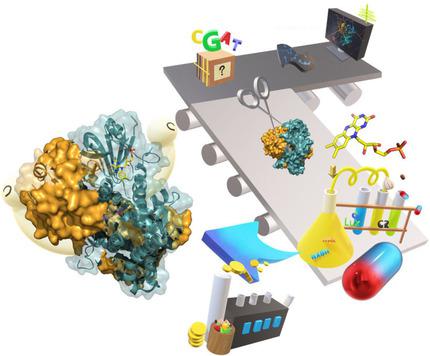当前位置:
X-MOL 学术
›
ChemBioChem
›
论文详情
Our official English website, www.x-mol.net, welcomes your
feedback! (Note: you will need to create a separate account there.)
Creating Flavin Reductase Variants with Thermostable and Solvent-Tolerant Properties by Rational-Design Engineering.
ChemBioChem ( IF 2.6 ) Pub Date : 2020-02-21 , DOI: 10.1002/cbic.201900737 Somchart Maenpuen 1 , Vinutsada Pongsupasa 2 , Wiranee Pensook 1 , Piyanuch Anuwan 2 , Napatsorn Kraivisitkul 3 , Chatchadaporn Pinthong 4 , Jittima Phonbuppha 2 , Thikumporn Luanloet 5 , Hein J Wijma 6 , Marco W Fraaije 6 , Narin Lawan 7 , Pimchai Chaiyen 2, 5 , Thanyaporn Wongnate 2
ChemBioChem ( IF 2.6 ) Pub Date : 2020-02-21 , DOI: 10.1002/cbic.201900737 Somchart Maenpuen 1 , Vinutsada Pongsupasa 2 , Wiranee Pensook 1 , Piyanuch Anuwan 2 , Napatsorn Kraivisitkul 3 , Chatchadaporn Pinthong 4 , Jittima Phonbuppha 2 , Thikumporn Luanloet 5 , Hein J Wijma 6 , Marco W Fraaije 6 , Narin Lawan 7 , Pimchai Chaiyen 2, 5 , Thanyaporn Wongnate 2
Affiliation

|
We have employed computational approaches-FireProt and FRESCO-to predict thermostable variants of the reductase component (C1 ) of (4-hydroxyphenyl)acetate 3-hydroxylase. With the additional aid of experimental results, two C1 variants, A166L and A58P, were identified as thermotolerant enzymes, with thermostability improvements of 2.6-5.6 °C and increased catalytic efficiency of 2- to 3.5-fold. After heat treatment at 45 °C, both of the thermostable C1 variants remain active and generate reduced flavin mononucleotide (FMNH- ) for reactions catalyzed by bacterial luciferase and by the monooxygenase C2 more efficiently than the wild type (WT). In addition to thermotolerance, the A166L and A58P variants also exhibited solvent tolerance. Molecular dynamics (MD) simulations (6 ns) at 300-500 K indicated that mutation of A166 to L and of A58 to P resulted in structural changes with increased stabilization of hydrophobic interactions, and thus in improved thermostability. Our findings demonstrated that improvements in the thermostability of C1 enzyme can lead to broad-spectrum uses of C1 as a redox biocatalyst for future industrial applications.
中文翻译:

通过Rational-Design Engineering创建具有热稳定性和耐溶剂性的黄素还原酶变体。
我们采用了计算方法FireProt和FRESCO来预测(4-羟苯基)乙酸酯3-羟化酶的还原酶组分(C1)的热稳定变异体。借助实验结果,两个C1变体A166L和A58P被鉴定为耐热酶,其热稳定性提高了2.6-5.6°C,催化效率提高了2到3.5倍。在45°C下进行热处理后,这两种热稳定的C1变体均保持活性,并且与野生型(WT)相比,细菌萤光素酶和单加氧酶C2催化的反应产生的黄素单核苷酸(FMNH-)降低。除了耐热性,A166L和A58P变体还表现出耐溶剂性。在300-500 K的分子动力学(MD)模拟(6 ns)表明,A166突变为L和A58突变为P导致结构变化,疏水相互作用的稳定性增加,从而提高了热稳定性。我们的发现表明,改善C1酶的热稳定性可以导致C1作为未来工业应用中的氧化还原生物催化剂的广谱应用。
更新日期:2019-12-30
中文翻译:

通过Rational-Design Engineering创建具有热稳定性和耐溶剂性的黄素还原酶变体。
我们采用了计算方法FireProt和FRESCO来预测(4-羟苯基)乙酸酯3-羟化酶的还原酶组分(C1)的热稳定变异体。借助实验结果,两个C1变体A166L和A58P被鉴定为耐热酶,其热稳定性提高了2.6-5.6°C,催化效率提高了2到3.5倍。在45°C下进行热处理后,这两种热稳定的C1变体均保持活性,并且与野生型(WT)相比,细菌萤光素酶和单加氧酶C2催化的反应产生的黄素单核苷酸(FMNH-)降低。除了耐热性,A166L和A58P变体还表现出耐溶剂性。在300-500 K的分子动力学(MD)模拟(6 ns)表明,A166突变为L和A58突变为P导致结构变化,疏水相互作用的稳定性增加,从而提高了热稳定性。我们的发现表明,改善C1酶的热稳定性可以导致C1作为未来工业应用中的氧化还原生物催化剂的广谱应用。











































 京公网安备 11010802027423号
京公网安备 11010802027423号